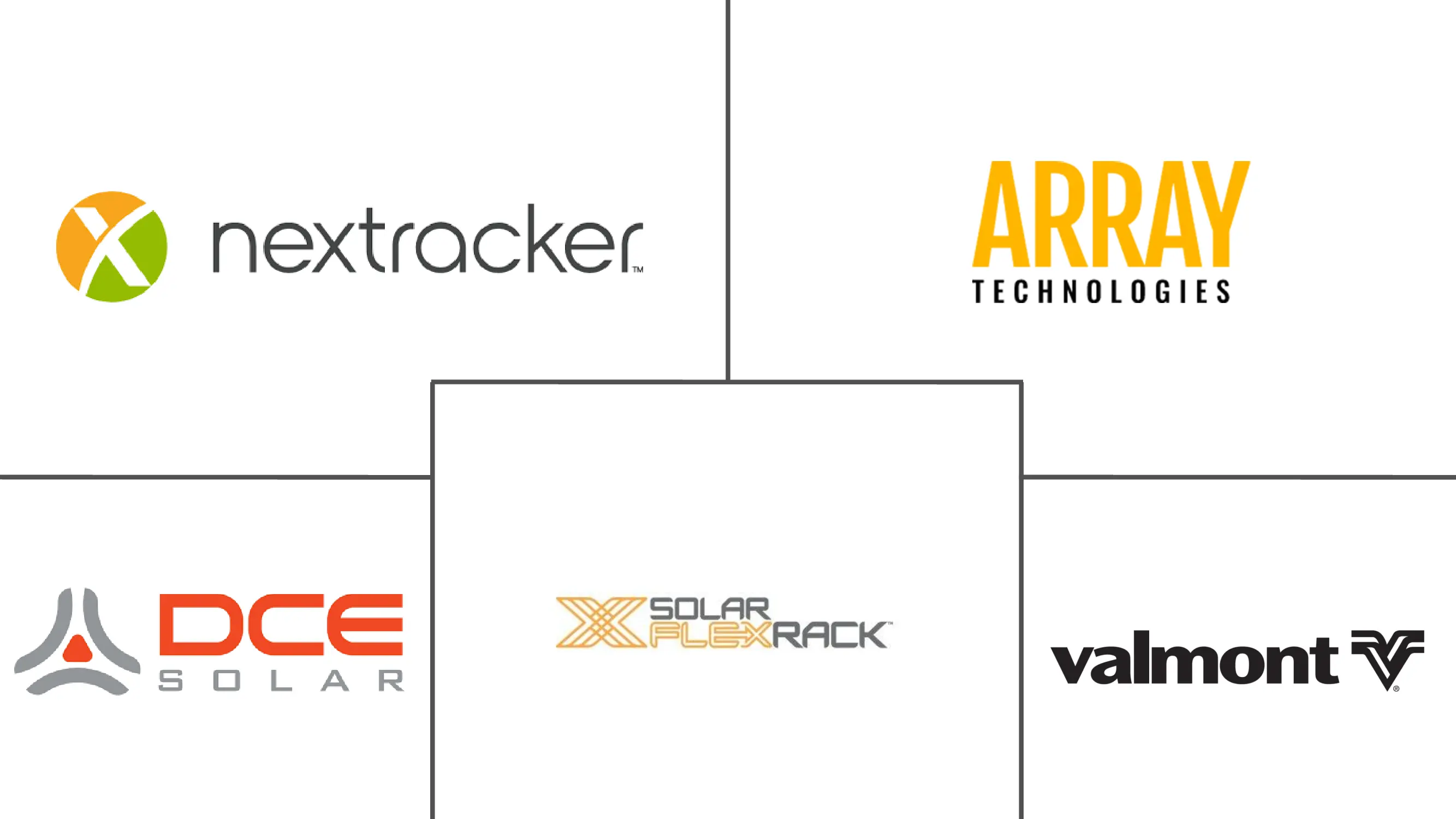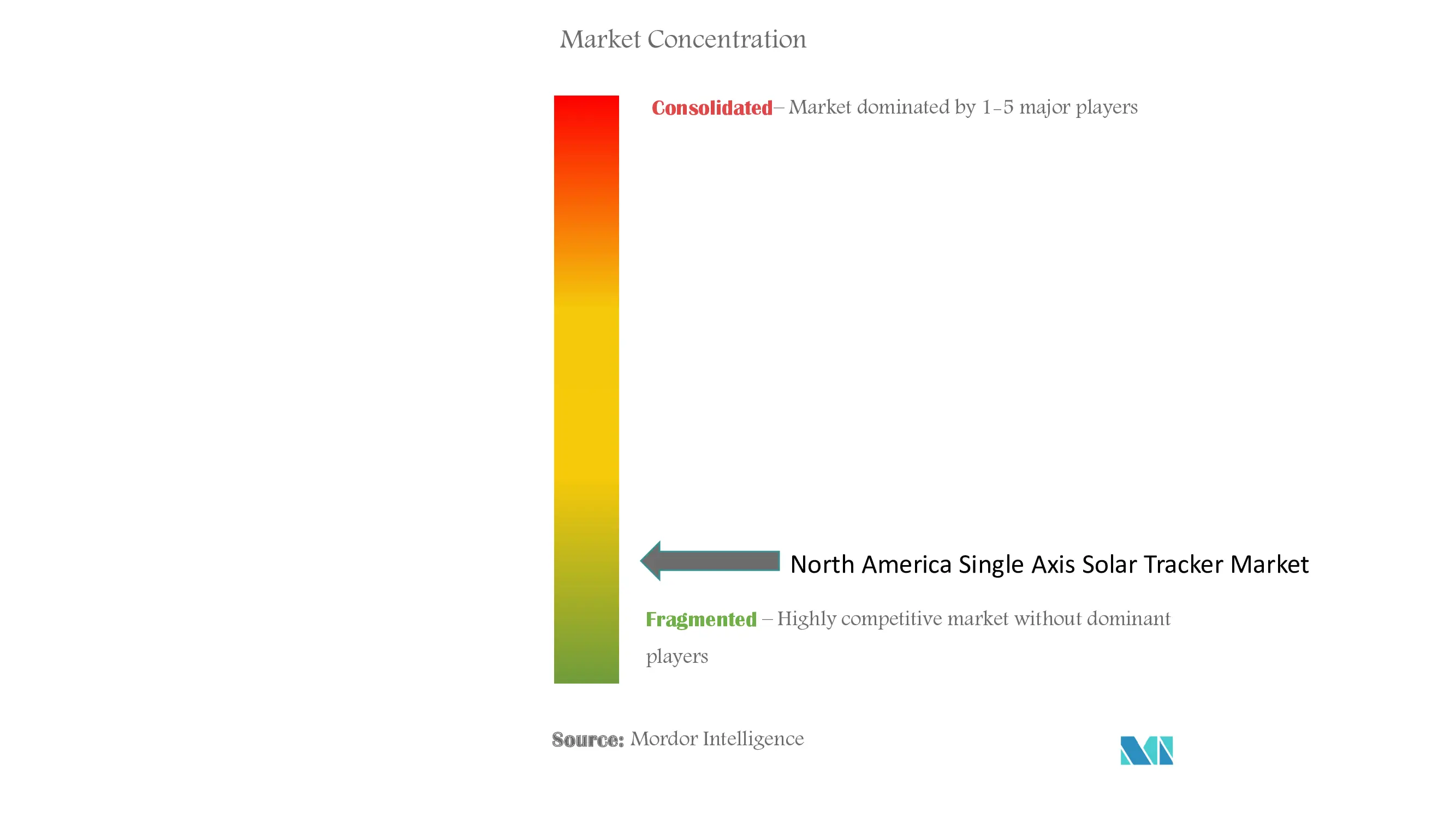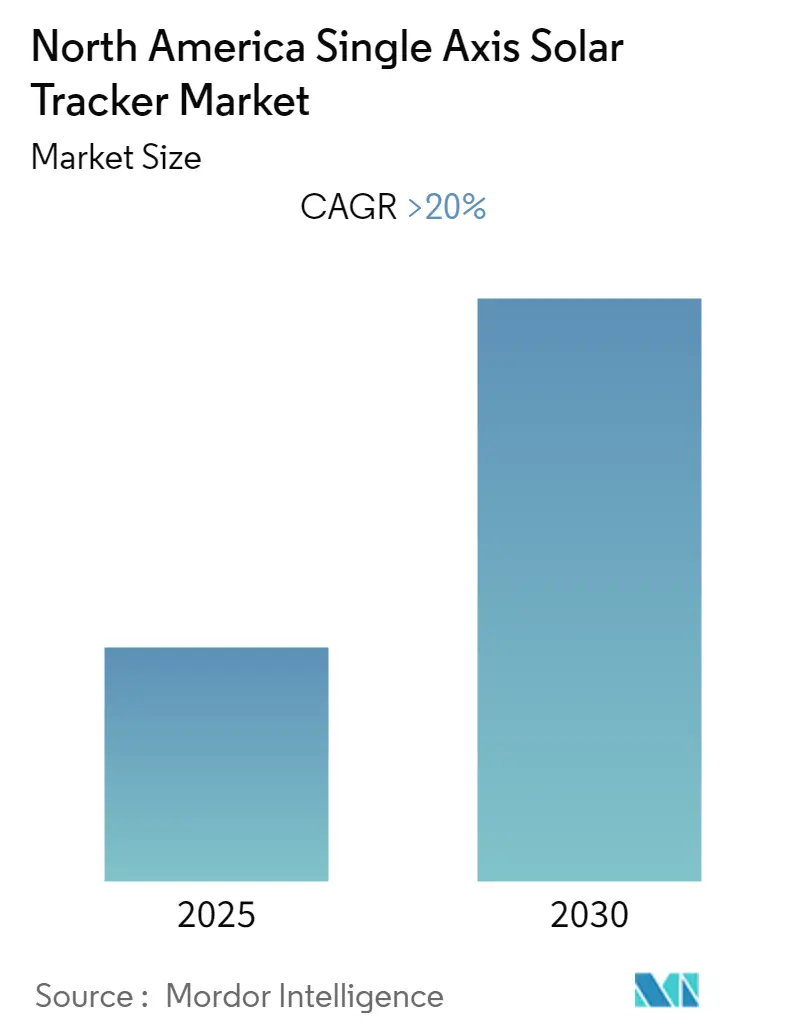
North America Single Axis Solar Tracker Market Analysis
The North America Single Axis Solar Tracker Market is expected to register a CAGR of greater than 20% during the forecast period.
The market was negatively impacted by COVID-19 in 2020. Presently the market has now reached pre-pandemic levels.
- Over the medium term, factors such as supportive government policies and efforts to meet power demand using renewable energy sources are expected to create a favorable market for solar panels as well as for solar trackers.
- On the other hand, the high initial investment required to install a tracking system, design complexity, maintenance cost, and the limited capacity of solar tracking systems is expected to restrain the usage of solar trackers.
- Nevertheless, energy companies and governments are facing a challenge to increase the power capacity, not only for future projects but also for active projects. With the installation of single-axis solar trackers, a capacity surge of 20%-30% can be achieved. This, in turn, is expected to create a significant amount of opportunities for the companies involved in solar tracking system manufacturing in the upcoming future.
- United States to dominate the market growth, due to to the increasing solar PV installation in the country.
North America Single Axis Solar Tracker Market Trends
United States to Dominate the Market Growth
- Solar power has become more accessible and prevalent in the United States than ever before. In the last decade alone, solar has experienced an average annual growth rate of 42%. Since the last decade, solar installations in the country have grown 30-fold. Total installed capacity in the United States reached 119.8 GW in 2021, representing an increase of about 25% compared to the previous year's value.
- Furthermore, distributed solar energy is also making significant progress across all the major markets in the country. Since 2010, the energy generated from the distributed solar system exceeded that of the solar utility installation. The distributed solar power generation market is mainly driven by strong federal policies like the solar Investment Tax Credit (ITC), rapidly declining costs, and increasing demand across the private and public sector for clean electricity.
- Further, the Solar Energy Industries Association (SEIA) is increasing its goal for Solar+ Decade, aiming for solar to account for 30% of the United States' electricity generation by 2030. The organization's previous goal was 20% by 2030, and this revision aligns with the recent government's clean energy targets while accounting for the growing urgency to tackle climate change and reduce carbon emissions in the electricity sector.
- In H1 2022, the country had cumulative installed capacity of around 25.61 GW of residential solar PV capacity. According to Solar Energy Industries Association (SEIA), in 2021, solar energy accounted for 46% of all new electricity generating capacity added to the grid. At the end of 2021, there were approximately 2.7 million distributed residential PV systems in the United States.
- In H1 2022, the total PV installed capacity in the commercial sector in the United States was 15.89 GW. Further, in till H1 2022, the United States has more than 130 gigawatts (GW) of solar energy capacity, which is enough to power 23 million homes which are additionally expected to rise till the end of 2022 and continue to surge significantly during the forecast period owing to a large portfolio of projects and supportive federal policies.
- Therefore, based on the above-mentioned factors, United States is expected to have a significant share in the North America single axis solar tracker market during the forecast period.
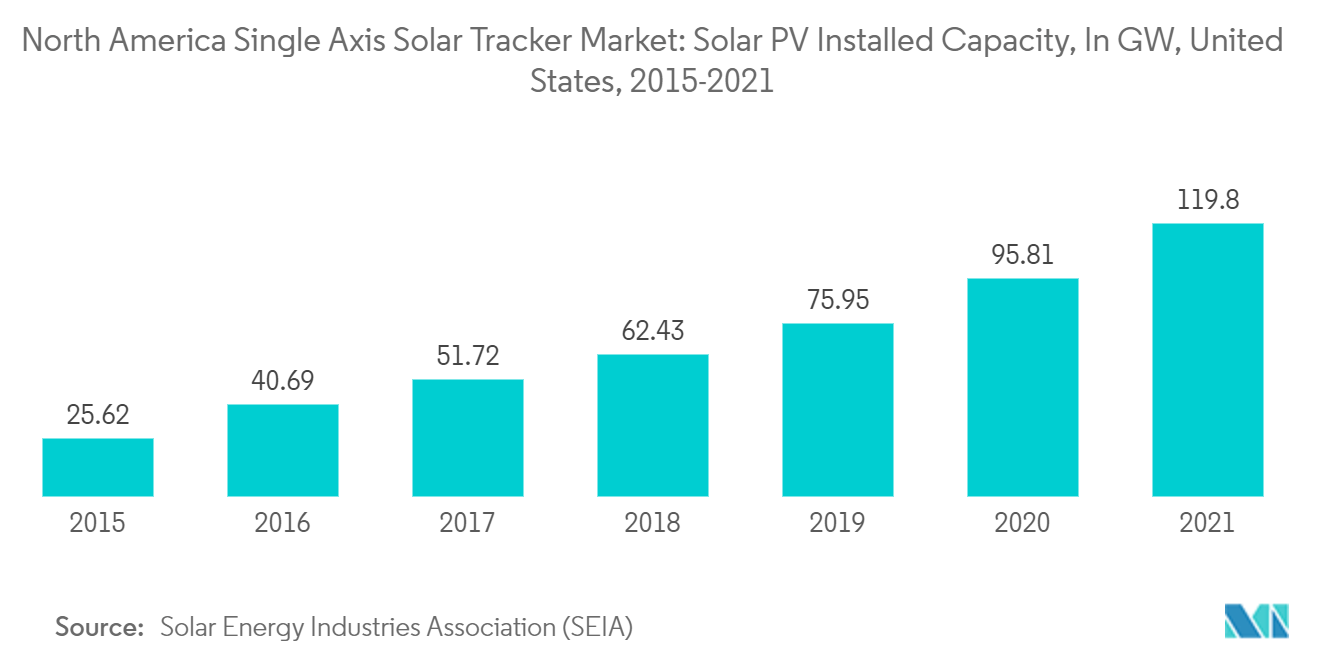
Supportive Government Policies And Efforts To Meet Power Demand Using Renewable Energy Sources
- North America generated 714.1 TWh of electricity from renewables in 2021, an increase of about 12.7% over the previous year.
- In Canada, the federal government announced that by 2025, 100% of the electricity used in their buildings and operations will be from renewable energy sources. This target is in support of a target to reduce the Federal Government's greenhouse gas emissions by 40% as early as 2025. Several provinces have set targets for increased percentages of renewables, and several cities, such as Edmonton, Victoria, Guelph, and Nelson, have committed to 100% renewable energy in the coming years, which is expected to create several opportunities for the single-axis solar tracker market.
- According to a report commissioned by the clean energy industry body - the Canadian Renewable Energy Association (CanREA), reaching 3 GW of rooftop solar in Ontario this decade could bring annual savings of up to CAD 244 million (USD 193 million) in 2030.
- Mexico's government also set an ambitious target of 35% renewable electricity by 2024 and 50% by 2050, up from 6.4% in 2018. Moreover, auctions have played an important role in large-scale renewable energy deployment in the country. After two successful renewable energy auctions in 2015 and 2016, the third round of auction was held in 2017, with solar getting the largest share of renewable energy projects (55%) for a total 1.3 GW of solar capacity contracted.
- Further, Mexico is expected to have significant growth in the utility sector on account of government initiatives, such as the 2021-2035 Development Program of the National Electrical System. The country is likely to increase power generation from clean renewable sources to reduce air pollution as per the program.
- An average price of USD 18.93 per MWh set a world record low at the time. Altogether, the three auctions allocated around 4.8 GW of solar generation capacity, with a cumulative investment of around USD 5 billion for about 40 solar power plants.
- Despite the ambitious targets and the clean energy certificate (CEC) scheme to support the development of renewable energy in the country, the underdeveloped power grid of Mexico is expected to pose a threat for future solar expansion, especially the large-scale solar PV plants that are developed in the remote areas of the country.
- The above-mentioned factors are expected to drive the demand for single axis solar tracker market over the study period.
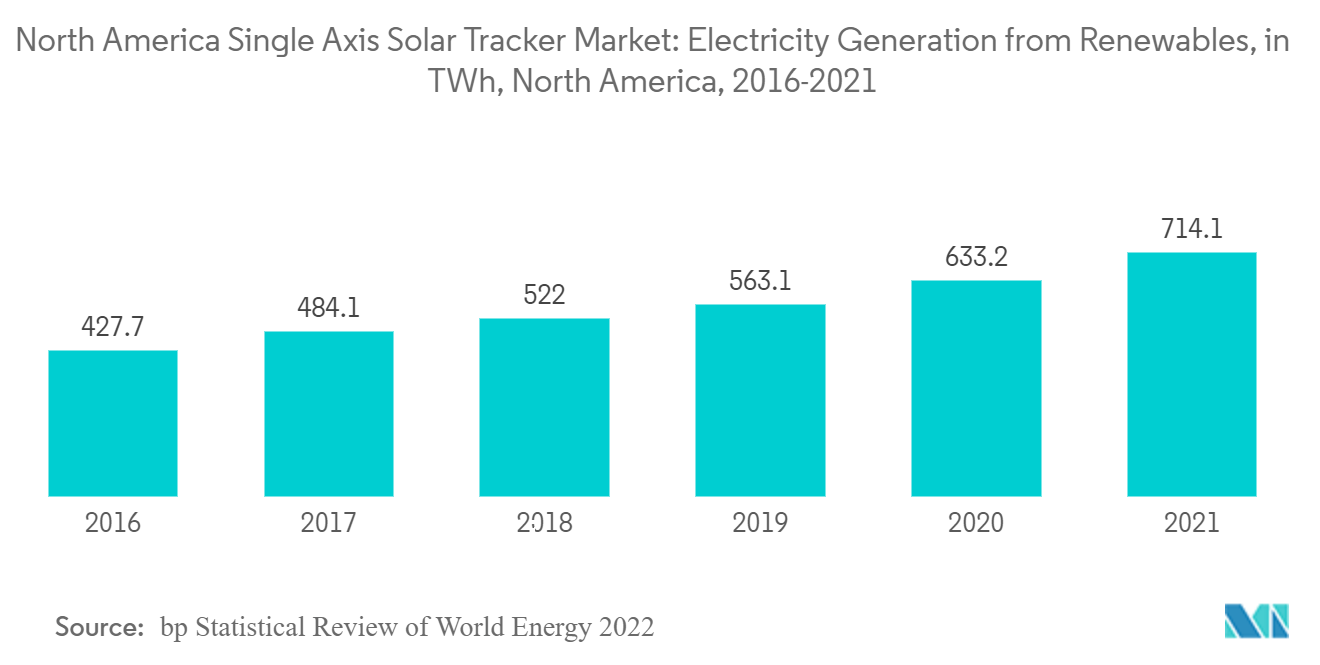
North America Single Axis Solar Tracker Industry Overview
North America single-axis solar tracker market is moderately fragmented. Some of the key players in the market (in no particular order) include Nextracker Inc, Array Technologies Inc., Solar Flexrack, DCE Solar, and Valmont Industries, Inc, among others
North America Single Axis Solar Tracker Market Leaders
-
Nextracker Inc
-
Array Technologies Inc
-
Solar Flexrack
-
DCE Solar
-
Valmont Industries, Inc
- *Disclaimer: Major Players sorted in no particular order
North America Single Axis Solar Tracker Market News
- In September 2022, FTC Solar, Inc., a leading provider of solar tracker systems, software, and engineering services, announced the launch of a new and differentiated module in portrait (1P) Single-Axis Solar Tracker Solution called Pioneer. The Pioneer supports all module factors, including those over 2.4 meters in length, providing clients with increased flexibility when designing projects. In addition, Pioneer operates independently from the grid during outages and is self-powered with a high-energy battery for up to three days of overall backup, offering increased energy resilience.
- In March 2022, NEXTracker launched the NX Horizon-XTR, a terrain-following, single-axis smart solar tracker which us likely to broaden the addressable solar power market on sloped, uneven, and challenging terrain by expanding the addressable market. In the last three years, Nextrackerhas deployed and empirically tested the NX Horizon-XTR at the utility scale, working closely with customers facing capital expense and construction challenges on hilly project sites. Using NX Horizon-XTR's terrain-following capabilities, grading can be reduced, steel costs can be minimized, and project risks can be decreased.
North America Single Axis Solar Tracker Industry Segmentation
A single-axis solar tracking system uses a tilted PV panel mount and one electric motor to move a PV panel in an approximate trajectory relative to the Sun's position. The rotation axis may be horizontal, vertical, or oblique. Using solar tracking technology, solar collectors, reflectors, and photovoltaic panels are oriented toward the sun. As the sun moves across the sky, a tracking device ensures that solar collectors maintain a position in which they receive the maximum amount of solar radiation as it moves across the sky. The North America single-axis solar tracker market is segmented by geography. The report covers the market size and forecasts for the solar panel recycling market across the countries in the region. For each segment, the market size and forecasts have been done based on revenue (USD billions).
| Geography | United States |
| Canada | |
| Mexico |
North America Single Axis Solar Tracker Market Research FAQs
What is the current North America Single Axis Solar Tracker Market size?
The North America Single Axis Solar Tracker Market is projected to register a CAGR of greater than 20% during the forecast period (2025-2030)
Who are the key players in North America Single Axis Solar Tracker Market?
Nextracker Inc, Array Technologies Inc, Solar Flexrack, DCE Solar and Valmont Industries, Inc are the major companies operating in the North America Single Axis Solar Tracker Market.
What years does this North America Single Axis Solar Tracker Market cover?
The report covers the North America Single Axis Solar Tracker Market historical market size for years: 2019, 2020, 2021, 2022, 2023 and 2024. The report also forecasts the North America Single Axis Solar Tracker Market size for years: 2025, 2026, 2027, 2028, 2029 and 2030.
Our Best Selling Reports
North America Single Axis Solar Tracker Industry Report
Statistics for the 2025 North America Single Axis Solar Tracker market share, size and revenue growth rate, created by Mordor Intelligence™ Industry Reports. North America Single Axis Solar Tracker analysis includes a market forecast outlook for 2025 to 2030 and historical overview. Get a sample of this industry analysis as a free report PDF download.

